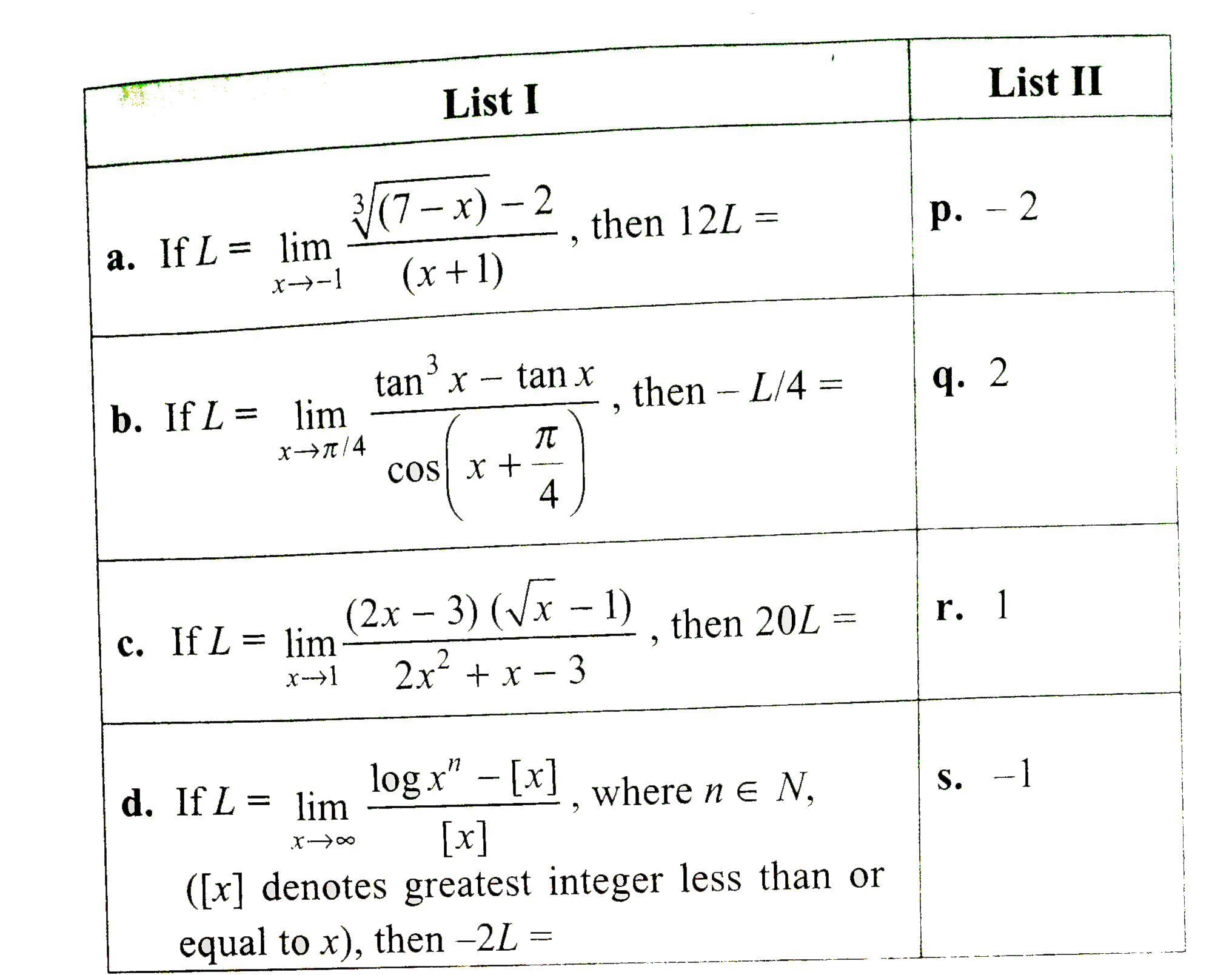Let f(x)={1+2xa,0≤x<1ax,1≤x<2.If(lim)x→1f(x)eξsts,thenais 1 (b) −1 (c) 2 (d) −2Solution in Tamil
f(x)x→5−=0
f(x)x→5+=1
limx→5f(x) does not exist
none of these
The correct Answer is:B, C
R.H.L.=limh→0f(1+h)=limh→0(1+h)=a
L.H.L.=limh→0f(1−h)=limh→0{1+2a(1−h)}=1+2a
limx→1f(x) exists ⇒R.H.L.=L.H.L. Therefore,
a=1+2a or a=2,−1
Topper's Solved these Questions
- LIMITSBOOK - CENGAGECHAPTER - LIMITSEXERCISE - Exercise (Comprehension)
20 Videos
- LIMITSBOOK - CENGAGECHAPTER - LIMITSEXERCISE - Exercise (Matrix)
5 Videos
- LIMITSBOOK - CENGAGECHAPTER - LIMITSEXERCISE - Exercise (Single)
76 Videos
- JEE 2019BOOK - CENGAGECHAPTER - JEE 2019EXERCISE - Chapter 10
9 Videos
- LINEAR COMBINATION OF VECTORS, DEPENDENT AND INDEPENDENT VECTORSBOOK - CENGAGECHAPTER - LINEAR COMBINATION OF VECTORS, DEPENDENT AND INDEPENDENT VECTORSEXERCISE - DPP 1.2
10 Videos
Similar Questions
Find the domain of f(x)=√|x|−{x} (where {⋅} denots the fractional part of x).
View SolutionMatch the following lists:

View Solution(lim)x→0[sin(sgn(x))(sgn(x))], where[.] denotes the greatest integer function, is equal to (a)0 (b) 1 (c) −1 (d) does not exist
View SolutionIf y = y(x) is the solution of the differential equation, xdydx+2y=x2 satisfying y(1) = 1, then y(12) is equal to
View SolutionThe number of integral values of p for which (p+1)ˆi−3ˆj+pˆk,pˆi+(p+1)ˆj−3ˆk and −3ˆi+pˆj+(p+1)ˆk are linearly dependent vectors is q
View SolutionLet f(x)={1+2xa,0≤x<1andax,1≤x<2 If limx→1f(x) exists ,then a is (a)1 (b) −1 (c) 2 (d) −2
View SolutionIf f(x)=3x2+ax+a+1x2+x−2, then which of the following can be correct (lim)x→1f(x)eξstsa=−2 (lim)x→−2f(x)eξstsa=13 (lim)x→1f(x)=43 (lim)x→−2f(x)=−13
View SolutionVerify Rolles Theorem for f(x)=sinxex ∈ [0,π] [c=π4] f(x)=1−x23 in [−1, 1] (f′(0)non eξstent)
View SolutionIf f(x)=cos2x+sec2x,then f(x)<1 (b) f(x)=1 (c) 2<f(x)<1 (d) f(x)≥2
View SolutionIf (lim)x→1asin(x−1)+bcos(x−1)+4x2−1=−2,then|a+b| is_______
View SolutionLet f(x)={1+2xa,0≤x<1andax,1≤x<2 If limx→1f(x) exists ,then a is (a)1 (b) −1 (c) 2 (d) −2
View SolutionIf f(x)=3x2+ax+a+1x2+x−2, then which of the following can be correct (lim)x→1f(x)eξstsa=−2 (lim)x→−2f(x)eξstsa=13 (lim)x→1f(x)=43 (lim)x→−2f(x)=−13
View SolutionIf y=eacos−1x,−1≤x<1,showthat (1−x2)d2ydx2−xdydx−a2y=0
View SolutionIf f(x)=cos2x+sec2x,then (a) f(x)<1 (b) f(x)=1 (c) 2<f(x)<1 (d) f(x)≥2
View SolutionThe value of (lim)x→π/2(secx−tanx) is a. 1 b . 0 c. 2 d. -1
View SolutionLet f(x): D to R be defined as f(x)=(x^2+2x+a)/(x ,^2+4x+3a),w h e r e' D ' is domain of f(x) . f(x) is a subjective function if [a] 1lt=alt=2 [b] 0 [c] 1/2 lt=a [d] 0 < a < 1
View Solution
